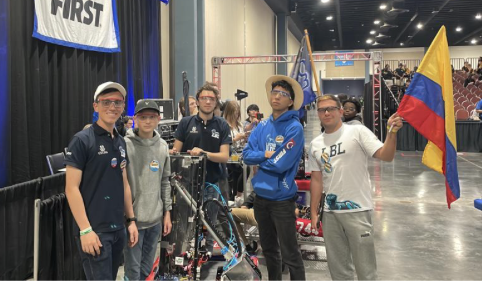Inside Look: 2023 FRC Competition through the eyes of its participants

Courtesy of Maria Adelaida Arango
Students Pablo Arango, Felipe Franco, Pablo Escandon, Santiago Restrepo, and Gabriel Meynard wait in queue before one of their matches.
As the adrenaline-fueled cheers of the audience echoed through the arena, the participants of the 2023 FIRST Robotics Competition could hardly contain their excitement. For weeks, they had poured their hearts and souls into designing, building, and programming their robots to compete in this ultimate display of technological prowess. After several restless nights and early weak-ups on weekends, the team finally managed to build the best robot LBL had ever created. But beyond the robots and the thrill of competition, the varied opinions of participants highlighted the diversity of experiences and perspectives at the event, which added to the overall success and positive atmosphere of the competition.
During the first week of March, the Lightning Blue Lizards, TCS robotics team, participated in First Robotics Competition’s South Florida Regional, for a spot in the world cup. Participants included Isaac Velez, Pedro Acosta, and Santiago Restrepo from the LBL, as well as Brianna Hamilton from the RoboRays, a team from Naples, Florida, who were challenged to design a robot that completes several tasks which vary year after year.
The contest brought together high school students and mentors worldwide to design, build, and compete with robots that perform the specific task of placing boxes and cones on elevated platforms. Participants praised the event for being a fun and exciting challenge that required impressive teamwork, innovation, creativity, problem-solving skills, and passion for robotics and engineering.
What was your favorite experience of the event?
Despite the intense competition, the varied responses of participants expressed how the event was a success which provided a diversity of enriching experiences and perspectives.
“It is a great opportunity to meet new people and learn new skills. I loved working on the robot and seeing it come to life,” Hamilton said.
“It was challenging, but it felt great to see our robot perform the tasks we designed it to do. During that match, the robot almost fell off the ramp, and yet it managed to compete and win. That was by far the best moment of the competition,” Isaac Velez, Grade 12, said.
What was your least favorite part of the event?
Despite the fact that most participants had nothing but nice things to say, they did feel there were a few things that could have been done better. Participants expressed concern about the financial differences between the competing teams. Some wished they could have practiced operating their robots for longer. Others believed that there should be more chances for team engagement outside of the tournament.
“I wish there had been more opportunities to interact with other teams outside of the field. We were all so focused on our own robots that we didn’t get to meet as many people as I would have liked,” Hamilton said.
“It’s great that some teams have the resources to build amazing robots, but it’s tough to compete against teams that clearly have more money to invest,” Pedro Acosta, Grade 10, said.
What were the most outstanding teams in the competition?
Participants highlighted that this year’s event brought many competitive and interesting robots to the ring. Teams were considered outstanding for several reasons like their robot’s mechanism, stability, or strength. Others were highlighted for their gracious professionalism and teamwork. Gracious Professionalism is a way of doing things that encourages high-quality work, emphasizes the value of others, and respects individuals and the community.
“Some outstanding teams were Children of the Swamp and Bizons because their robot was very stable, effective, and incredibly fast. In addition, their autonomous system worked perfectly,” Restrepo, Grade 12, said.
“The Ninjineers were always there to help us out. We are really thankful because even in our hardest times, several members would come and help us fix our robot,” Acosta said.
What were the difficulties of this year’s challenge?
This year’s competition presented unique challenges for participants. With a new focus on cones and cubes instead of balls like in previous years, teams had to design new intake mechanisms, an idea that was completely new and challenging for many teams. Additionally, defense rules were more flexible this year, meaning robots had to be stronger and more resistant in order to be competitive and overcome those defensive strategies.
“Our robot had been working pretty well until it began deteriorating after so many crashes. This made various mechanisms weak and that affected our performance,” Restrepo said.
“I had never built an intake system that didn’t revolve around collecting balls. This changed our team’s plans drastically at the beginning of the season and made it way more challenging.” Hamilton said.
What were the most stressful moments of the competition?
Preparing for the 2023 FIRST Robotics Competition was a challenging experience for students and mentors alike. Participants faced long hours, tight deadlines, and fierce competition.
“The night before the competition, we didn’t have our compressor as it had broken on the way to Miami. Once we noticed, it was 9 pm and we couldn’t afford to buy a new one. Fortunately, there was a team member’s father who was coming to Miami the following day and he brought us a new one. Without him, we would have never even competed,” Restrepo said.
“There were intense moments when we had to make split-second decisions. But that’s what makes the competition exciting.” Velez said. “The lead-up to the competition was intense. It was hard to know when to stop tinkering and just trust that we had done our best.”



